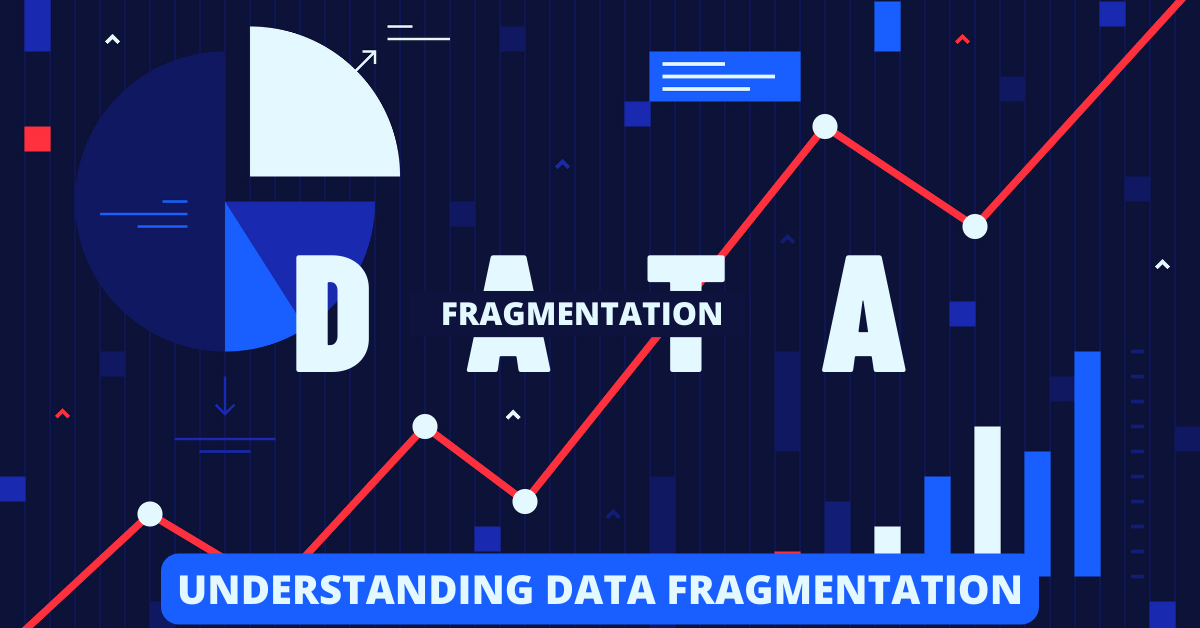Data fragmentation and encryption significantly enhance data security by making it difficult for unauthorized persons to access or interpret the data
In today’s digital landscape, where sensitive information is constantly at risk of being compromised, organizations seek effective ways to enhance their data security measures. Two commonly used techniques in this pursuit are data fragmentation and encryption. While these techniques serve distinct purposes, their combined use offers an even stronger defense against potential cyber threats. Together, We will explore the profits, challenges, and future trends surrounding the interplay between data fragmentation and encryption.
Understanding Data Fragmentation

Data fragmentation breaks down data into smaller, more manageable components or fragments. This technique involves splitting data into multiple segments that can then be stored across different locations or systems. The basic principle behind data fragmentation is to minimize the impact of a potential data breach by dispersing data across various sources.
Data fragmentation is a crucial strategy in data management and security. It plays a significant role in protecting sensitive info from unauthorized access and potential cyber threats. By dividing data into smaller units, data fragmentation ensures that the entire dataset remains secure even if one fragment is compromised.
The Basics of Data Fragmentation
Data fragmentation involves dividing data into smaller units, such as files, records, or individual data elements. Each fragment contains a portion of the complete dataset, ensuring that no single fragment can provide access to the entire set of data. This approach effectively limits the potential damage a cyber attacker can inflict if they gain access to one fragment.
Horizontal fragmentation is one of the common approaches to data fragmentation. It distributes rows of a database table across different systems or locations. For example, customer records could be horizontally fragmented in a customer database based on geographical regions. This distribution ensures that customer data is stored closer to customers, improving data access speed and reducing network latency.
Vertical fragmentation, on the other hand, segregates columns of a table based on specific attributes. For instance, in an employee database, employees’ personal information, such as names, addresses, and contact details, could be vertically fragmented. This fragmentation technique allows organizations to control access to sensitive information more effectively and ensure that only authorized personnel can access specific data attributes.
The Role of Data Fragmentation in Security
By splitting data into fragments and dispersing them across different systems or locations, data fragmentation significantly reduces the chances of a successful data breach. Even if an attacker manages to gain illegal access to one fragment, they would only have limited access to a fraction of the complete dataset, making it much more challenging to exploit or misuse the compromised information.
Data fragmentation is fundamental to data security strategies, especially in industries dealing with sensitive information like healthcare, finance, and government sectors. It adds a layer of protection against potential threats, ensuring that the overall data integrity remains intact even if one fragment is compromised.
Beyond enhancing security, data fragmentation also offers additional benefits, such as improved performance and scalability. Distributing data across multiple systems can optimize resource utilization and ensure efficient retrieval and processing. With data fragmentation, organizations can achieve better load balancing, as the workload is distributed across different systems, preventing bottlenecks and improving overall system performance.
Moreover, data fragmentation enables organizations to scale their data storage and processing capabilities more effectively. As the volume of data grows, establishments can add more systems or locations to store additional data fragments, ensuring that the system can handle the increasing workload without sacrificing performance or security.
In conclusion, data fragmentation is a crucial technique in data management and security. It divides data into smaller fragments, ensuring that the entire dataset remains secure even if one fragment is compromised. This approach enhances data security, improves performance, and enables scalability, making it an essential strategy for organizations dealing with sensitive and valuable data.
Delving into Data Encryption
Data encryption is another crucial technique employed to safeguard sensitive information. Encryption involves transforming data into an unreadable format without the corresponding decryption key. This process ensures that even if unauthorized individuals obtain encrypted data, they cannot decipher its contents without the encryption key.
Data encryption is dynamic in protecting sensitive info across various industries and sectors. It is widely used in finance, healthcare, government, and e-commerce. By implementing encryption, organizations can mitigate the risk of data breaches and unauthorized access, safeguarding the confidentiality and integrity of their data.
What is Data Encryption?
Data encryption involves using mathematical algorithms to convert plaintext data into ciphertext, which is unreadable without the appropriate decryption key. The encryption key serves as the means to unlock and access the encrypted data. Common encryption algorithms include Advanced Encryption Standard (AES), Rivest-Shamir-Adleman (RSA), and Data Encryption Standard (DES).
Encryption algorithms are designed to be computationally intensive, making it very difficult for unauthorized individuals to reverse-engineer the encryption process and obtain the original data. These algorithms utilize complex mathematical functions and cryptographic techniques to safeguard the confidentiality and security of the encrypted data.
How Data Encryption Contributes to Security
Data encryption provides an additional layer of protection by ensuring that even if confidential information falls into the wrong hands, it remains unintelligible without the proper decryption key. This technique thwarts attempts to access or manipulate sensitive data, rendering it useless to unauthorized individuals.
Moreover, data encryption helps organizations comply with various data protection regulations and standards. For instance, the General Data Protection Regulation (GDPR) requires organizations to implement appropriate technical and organizational measures to protect personal data. Encryption is considered one of the most effective measures to achieve compliance with such regulations.
Encryption is often employed during data transmission, such as through secure socket layer (SSL) or transport layer security (TLS) protocols, to safeguard data as it travels between systems. This encrypts the data, protecting it from interception or tampering during transit.
Furthermore, encryption can protect data at rest, such as on storage devices or databases. By encrypting data at rest, organizations can ensure that even if physical devices are lost or stolen, the data remains secure and inaccessible to unauthorized individuals.
It is important to note that the strength of data encryption relies heavily on the encryption algorithm’s difficulty and the encryption key’s length. Longer encryption keys and more advanced algorithms provide a higher level of security, making it more challenging for attackers to break the encryption and access the data.
In conclusion, data encryption is a crucial component of modern-day security measures. It helps protect sensitive information, ensures compliance with data protection regulations, and safeguards data during transmission and at rest. By implementing robust encryption techniques, organizations can enhance the security of their data and maintain the trust of their customers and stakeholders.
The Interplay Between Data Fragmentation And Encryption

While data fragmentation and encryption are distinct techniques, their combined use can enhance data security even further.
How Fragmentation and Encryption Work Together
Data fragmentation and encryption can be used together to create an additional layer of defense for sensitive data. By encrypting each fragment individually, even if an attacker manages to gain access to a fragment, they would still be unable to decipher its contents without the corresponding decryption key.
Furthermore, coupling data fragmentation and encryption can provide additional complexity and protection. With data dispersed across multiple fragments and encrypted using robust cryptographic algorithms, potential attackers face a challenging task in attempting to exploit the compromised information.
Benefits of Combining Fragmentation and Encryption
Combining data fragmentation and encryption increases the security of sensitive information and enhances the overall resilience of data systems. This approach decreases the risk of a single point of failure and minimizes the potential impact of a breach committed against a specific fragment. Furthermore, combining these techniques allows for more granular control over data access and improved compliance with data privacy regulations.
Potential Risks and Challenges

While data fragmentation and encryption provide significant security advantages, it is essential to consider potential risks and challenges.
Possible Drawbacks of Data Fragmentation
Data fragmentation may introduce complexities related to data retrieval and integration. As data is spread across multiple sources, consolidating and accessing fragmented data can be more time-consuming and resource-intensive. Additionally, ensuring optimal synchronization and data consistency between fragments requires careful management and coordination.
Potential Pitfalls of Data Encryption
Although data encryption offers robust protection against unauthorized access, it is crucial to manage encryption keys securely. Losing or compromising encryption keys can result in permanent loss of encrypted data, as there is no feasible method for recovery without the keys. Proper key management practices, such as regular backups and secure storage, are essential to avoid such pitfalls.
Future Trends in Data Security
The field of data security is continually evolving, driven by emerging technologies and evolving threats.
Emerging Technologies in Fragmentation and Encryption
Advancements in technologies such as blockchain, homomorphic encryption, and secure multi-party computation are shaping the future of data security. These technologies provide innovative data fragmentation and encryption approaches, offering enhanced security, privacy, and flexibility.
The Future of Data Security with Fragmentation and Encryption
As cyber threats continue to evolve, data security remains paramount. The future of data security lies in the seamless integration of multiple techniques, including data fragmentation and encryption, to provide comprehensive protection. The field will witness algorithm advancements, key management practices, and secure data-sharing methodologies to address emerging challenges and ensure robust data security across various industries.
In conclusion, data fragmentation and encryption are powerful tools in the fight against cyber threats. While each technique plays a distinct role, combining data fragmentation and encryption offers a multi-layered approach to data security. By leveraging these techniques, organizations can enhance their ability to protect sensitive information and mitigate the risks associated with data breaches. As the data security landscape evolves, staying abreast of emerging technologies and best practices will be crucial in maintaining effective data protection strategies.
Key Takeaways
- Fragmentation breaks data into smaller pieces, making it harder to compromise.
- Encryption converts data into unreadable code, adding an extra layer of security.
- These methods are often used in combination for maximum security.
- Fragmentation and encryption are resource-intensive but necessary for sensitive data.
- Both methods are commonly used in secure cloud storage solutions.
FAQs
What is data fragmentation?
Data fragmentation is breaking data into smaller, disjoint pieces to enhance security and efficiency.
Is encryption enough for security?
While encryption is effective, combining it with other methods like fragmentation offers higher security.
Are these methods foolproof?
No security method is 100% foolproof, but these methods significantly reduce the risk of data compromise.
Do these methods slow down data access?
Yes, they can slow down data retrieval, but the trade-off is enhanced security.
Can I use these methods on my devices?
Yes, many software and applications offer options for data encryption, and some advanced solutions offer fragmentation as well.
Conclusion
In conclusion, data fragmentation and encryption are powerful tools in the fight against cyber threats. While each technique plays a distinct role, combining data fragmentation and encryption offers a multi-layered approach to data security. By leveraging these techniques, organizations can enhance their ability to protect sensitive information and mitigate the risks associated with data breaches. As the data security landscape evolves, staying abreast of emerging technologies and best practices will be crucial in maintaining effective data protection strategies.
